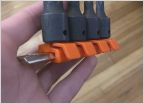-
Welcome to Tacoma World!
You are currently viewing as a guest! To get full-access, you need to register for a FREE account.
As a registered member, you’ll be able to:- Participate in all Tacoma discussion topics
- Communicate privately with other Tacoma owners from around the world
- Post your own photos in our Members Gallery
- Access all special features of the site
Physics question...propulsion in a swimming pool
Discussion in 'Off-Topic Discussion' started by Veccster, Jul 2, 2012.
Page 3 of 3
Page 3 of 3


 Cellphone indoor signal booster
Cellphone indoor signal booster Wood and metal wedding bands?
Wood and metal wedding bands? TW does it again!
TW does it again! Mystery Socket Rail Brand
Mystery Socket Rail Brand Bed Sheets
Bed Sheets Video call question
Video call question










































































